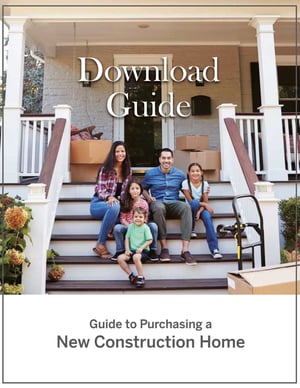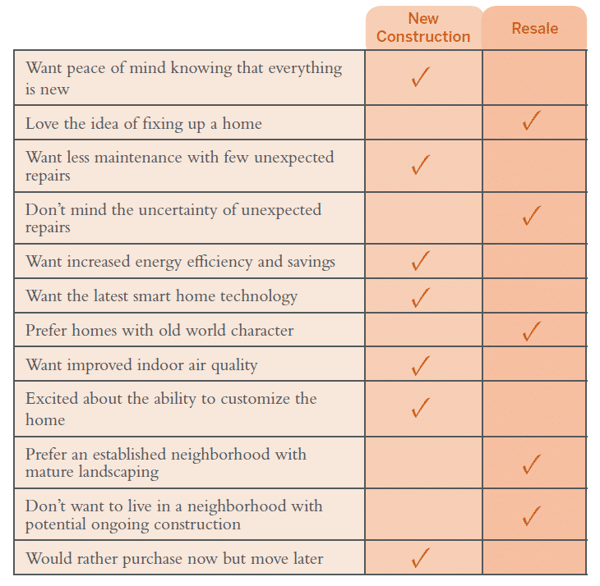
Purchasing a new home is an exciting process and there are many things to consider. These include which neighborhood you want to live in, what type of home (single family, townhome or condo) and whether to purchase a new construction home or a resale.
When considering new construction versus resale, there are a number of questions you should ask yourself. Do you love the idea of fixing up a home or would you prefer a home with low maintenance? Is it important for you to have a smart home with the latest technology and energy saving features?
This guide is intended to help you decide if purchasing a new construction home may be the right choice for you. We’ll compare the benefits of purchasing a new home versus an older home, describe the construction process and more.

Should I buy a new construction home or resale? This is a question many home shoppers ask when beginning their new home search. Which one is right for you can depend on many factors, including lifestyle preference and personal priorities. If your ideal home has the latest new home technology, energy efficient features and requires little to no maintenance, then new construction may be the better choice for you. If you love the idea of fixing up a home and prefer to live in a developed neighborhood with mature landscaping, then an older home may better suit your lifestyle.
Below are some preferences to consider to help you determine which type of home may better suit your lifestyle and priorities.

1. Less Maintenance
2. Increased Energy Efficiency
3. Ability to Personalize
4. Latest "Smart" Home Technology
5. Improved Air Quality
6. Includes Builder's Warranty
7. Wider Buying Timeframe Options
8. Peace of Mind
When comparison shopping, one may find that a new construction home costs more than a similar sized older home. However, it is important to take into consideration that with a new construction home, there will likely be far fewer repairs and renovations needed throughout the time you are living in the home. Not only is EVERYTHING new, but you have already customized the home so you won’t need to update it to suit your personal style.
There is a lot to consider when deciding what type of home will be right for you – what features you want in the home, what type of neighborhood you want to live in, how much maintenance you are willing to do, and more. Talking to experienced professionals such as Realtors and home builders, as well as doing your own research, can help you make the best decision for you in your new home search.
Click these links for articles providing information on typical costs for renovations and maintenance.
New Home Source: The Top 10 Reasons Home Buyers Prefer New vs. Used
https://www.newhomesource.com/guide/articles/top-10-reasons
Zillow: New Construction Vs Existing Homes - The Pros and Cons of Both
https://www.zillow.com/learn/buying-a-new-home/
New Home Source: New Home or Resale, Which is Right for You?
https://www.newhomesource.com/guide/articles/new-homes-vs-resale-which-is-right-for-you
Download the Guide to read more.
Watching your dream home come to life is an exciting experience and a lot more goes into building your home than you may be aware of. While the following list is not exhaustive of every step included in building a home (and processes may vary by builders), below are the basic phases in the home building process, in approximate order.
1) Building Pad Preparation
2) Framing & Carpentry
3) Rough-In, Air Sealing & Insulation
4) Drywall & Interior Finishing
5) Exterior Finishing
6) Final Walk-Through & Quality Assurance
Download the Guide for more details on the construction process.
How long it takes to build a home will vary due to many factors such as the type of home being built, time needed to obtain permits, weather conditions, your location and more.
According to a 2022 Survey of Construction from the Census Bureau, the nation-wide average time to build a single family home is 7 months.* Production homes take less time (average 6 months) while custom homes take longer (average 9 months). Production homes are built as part of new community and typically offer fewer options. Custom homes may be a single home or part of a community and offer more options and customization.
Build time also varies by region, with the Mid-Atlantic region averaging 9.5 months.
If you are purchasing a condo in a brand new building, it may take two years or more for the building to be completed.
One thing to keep in mind is that construction delays are possible and may be due to circumstances outside a builder’s control. Be sure to keep in regular communication with your builder to stay informed of any potential delays.
*Source: https://www.newhomesource.com/guide/articles/how-long-does-it-take-to-build-a-house
Due to various factors, builders may begin the construction process on a homesite before anyone has purchased it. For example, if a builder is building a row of townhomes and all of the homes in the row have sold except for one, that home still needs to be built along with the others. If that home gets built to completion without anyone purchasing it, it is often referred to as a “spec home.” Spec homes are finished (or almost finished) homes that have a quick move-in timeframe.
The advantage of a spec home is that you could move into a brand new home right away. The disadvantage is that you wouldn’t have the opportunity to customize the home as it is already completed. Whether or not a spec home may be the right choice often depends upon a person’s desired moving timeframe.
Many of the steps in purchasing a new construction home are similar to purchasing a resale. You will need to sign a contract, secure a loan from a bank (or show you have the assets to cover the cost of the home) and go through the closing process. However, there are some additional steps in purchasing a new construction home, such as selecting options for the home and meeting with the builder for walk-throughs during various stages of the building process.
While the processes will vary by builder, below is a general overview of the purchasing process for new construction homes.
1) Purchase Agreement
2) Securing a Loan
3) Options Meetings
4) Home Walk-Throughs
5) Closing
6) Home Warranty
Download the Guide for more information on the purchasing process.
Most builders do have purchasers who work with Realtors. When purchasing a resale home, it is typically the seller who pays the Realtor fees. It is similar when purchasing a new construction home, as the builder will typically pay the agreed upon Realtor fees. Be sure you know who will pay all associated fees upfront.
Realtors can be valuable sources of information regarding the reputation of the builder, home price comparisons and more. However, the builder sales representatives are also excellent resources who will have the in-depth knowledge of the local market, the homes, comparable pricing, etc. Whether or not you prefer to work with a Realtor will depend on your own preference. The key is to work with someone you trust and who has the experience, market knowledge and understanding of what you are looking for in a new home and neighborhood.
One of the advantages of purchasing a new construction home is that you get to choose all the features and finishes to customize the home for your lifestyle and personal preferences. This could include everything from the number of bedrooms and baths to choosing whether to add optional features such as an outdoor wet bar or living room fireplace.
While this can be very exciting for some, it can also be stressful for others as there are many decisions to be made. To help make this process less overwhelming, familiarize yourself with key terms and the selections process and allow plenty of time to make the decisions that will bring you happiness for years to come.
Builders typically have a variety of resources to help you in the options selection process. While some builders may have a showroom, others may have model homes that feature various products. Visiting the showrooms and model homes is very useful for seeing color combinations and how the items will actually look in the home. Many builders will also have a dedicated staff member to help you with the selections process. This person will offer guidance on selecting options for your lifestyle, what items do or do not go well together, pricing and more.
If construction on your home has started prior to your entering into a contract, it may be too late to choose certain options. The options you will be able to select will vary depending on how far along your home is in the construction process. For example, it may be too late to select structural options but you may still have time to select finish options.
Selecting options is time-sensitive as it could impact how quickly your home gets built. Be sure to stay in communication with your builder on the necessary timing for options meetings.
Between the time you select the options and the time they are put in the home, occasionally models may be discontinued and options may need to change. Most builders will work to ensure a comparable product is selected and will notify you of any change.
Standard vs Upgrade
Standard Features: Builders typically offer standard items that are included in the negotiated sales price of the home. This may include items such as standard flooring, cabinets, faucets, appliances and more. Be sure you are clear what items are included in the sales price of the home before you sign the contract.
Upgrade Features: Available upgrades can vary greatly by builder. They may include structural options such as rear decks and finish options such as faucets, fireplaces, and lighting.
Structural vs Finish Options
Structural Options: Structural options include items that impact how the home is built. Examples include whether you would like to turn a study into an extra bedroom, add a rear deck or other changes to the home’s layout. If you are purchasing a custom built home, you will likely have more options to choose from than if you are purchasing a production home. These decisions need to be made early in the construction process.
Finish Options: Finishes refer to items that are the finishing touches of the home – cabinets, countertops, faucets, lighting and more. Decisions on finish options can be made later in the construction process.
Mix and Match vs Packages
Mix and Match: Custom home builders may offer purchasers the option to select each individual option in the home, or at least a wide variety of them. This is typically called mix and match as you can mix appliances, cabinetry or whatever you desire.
Packages: Builders may offer various packages, such as a standard kitchen package vs an upgrade kitchen package. You would not get to choose the individual items in the package (refrigerator, dishwasher, oven, etc) but would select all the appliances as a group. This type of options process may be preferred by those who would like to make fewer decisions and is likely offered more often by production builders.
When considering what options to choose, there are several things to keep in mind.
Choose what makes you happy
This will be your home for years to come so select the features that suit your lifestyle and represent your personal preferences. Consider your present and future lifestyle: what are your activities, hobbies and entertaining style? Trends will come and go, so be sure to select items that appeal to you personally. And remember that neutrals never go out of style.
Consider what features will improve the home value
It may be easier to justify spending money on upgraded options if you think they will help you sell the home in the future. Items such as upgraded kitchens, smart home technology and hardwood flooring are typically at the top of buyers’ wish list for a new home.
Make sure you don’t exceed your loan qualification amount
While that extra bedroom or bath may sound great, be sure to check with your lender so you do not exceed your maximum loan qualification.
In the end, if you take the time to prepare for the selections process and choose items that suit you personally, your new home will represent your unique style and bring you happiness for years to come.
